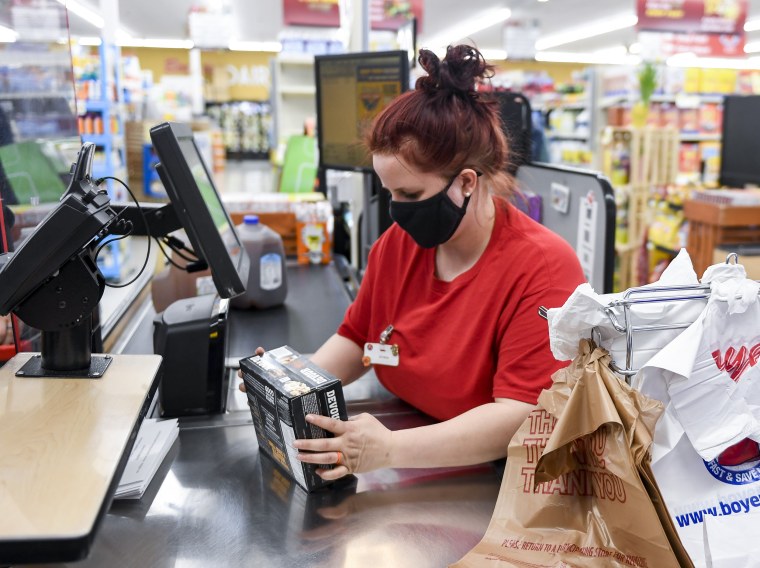Positive labor market data released Thursday added to rising confidence that the economy is returning in full force, with the latest weekly initial jobless claims falling below 400,000 for the first time since the coronavirus pandemic's chokehold strained the nation.
Initial applications for unemployment benefits fell to 385,000 for the week ended May 29, according to data released Thursday by the Labor Department.
Payroll processing firm ADP also reported better-than-expected numbers on Thursday, revealing that 978,000 people had been hired in May, the biggest gain since June 2020. Economists had predicted that May hirings would total around 680,000.
The latest employment metrics bolster the prevailing optimism about Friday’s closely watched monthly jobs report, with economists polled by Dow Jones projecting gains of 674,000.
“We have reason to believe the economic recovery will remain on track in the coming months,” said Mark Hamrick, senior economic analyst at Bankrate.com, citing the increased number of vaccinated Americans and more widespread reopenings.
Aaron Sojourner, labor economist and associate professor at the University of Minnesota, said the increase in vaccinations is a catalyst for job growth. “This boosts labor supply, as more Americans protect themselves, their families, and neighbors against Covid health risks previously created by work,” he said. “Vaccinations also boost labor demand, making it safe for people to enjoy in-person services.”
Vaccinations boost labor demand, making it safe for people to enjoy in-person services.
Frank Fiorille, vice president of risk management, compliance and data analytics at Paychex, said data from the company’s 350,000 small-business clients reveals that some employers are raising pay to coax workers off the sidelines.
In leisure and hospitality — one of the hardest-hit sectors throughout the pandemic — weekly pay has risen by nearly 10 percent over the past year, Fiorille said. “We’re seeing wages rise dramatically in that sector. The feeling is these businesses are having to pay them more to have them come back to work” he said.
And those employers recently have ramped up their hiring initiatives, said Nick Bunker, economist at Indeed.com. “Categories that have seen their level increase the most recently have been in the really pandemic-constrained sectors of the labor market,” he said, adding that job ads across all sectors are running about 26 percent above pre-pandemic levels.
“In light of last month’s report, this month’s is really important to give us a sense of whether last month was a blip or a sign of a bigger story in the labor market,” Bunker said of the upcoming labor market report.
While economists — and officials — say there can be enough noise in the data for any one month to be an anomaly, a second big miss would be a red flag, a warning sign for investors and politicians alike that the trajectory towards post-pandemic normalcy isn’t necessarily a straight line.
Sam Stovall, chief investment strategist at CFRA Research, said he plans to keep an eye on the numbers in manufacturing. The sector lost 18,000 jobs last month, and further erosion could indicate that supply chain bottlenecks and shortages of raw materials or components could be holding back economic activity. “It’s not that people don’t want to work or don’t want to increase production. They don’t have the means with which to do so because of supply disruptions,” he said.
“If we continue to get lower numbers, I think that is consistent with stories around schools not being fully reopened and parents having difficulty with childcare arrangements… and issues around eldercare. These are still quite powerful reasons for people deciding not to come back into the labor force,” said William Rodgers, professor of public policy and chief economist at Rutgers University’s Heldrich Center for Workforce Development. “We’re not out of the woods yet,” he said.
“If there's any sort of headwind, it’s that small businesses are having a hard time finding employees to fill the jobs,” Fiorille said.
A second monthly report of soft job gains would have potentially significant ramifications for the Biden administration, Stovall said. “If we do come in again weaker than expected, I think people are going to say, what’s going on here?” he said. A miss would almost certainly reignite the debate over the $300 weekly enhanced unemployment benefits. The federal program ends Sept. 6, but 25 governors are winding down the programs in their states sooner, with some ending as early as June 12.
Republicans in GOP-led statehouses as well as in Congress say the more generous unemployment benefits are keeping workers on the sidelines. “I think it would increase the rhetoric and would probably hinder the current administration's attempt to add additional stimulus,” Stovall said.
Other economists have pointed to a host of other barriers preventing people from returning to work. Fear of contracting Covid-19 is still a reality, especially in areas where local vaccination rates are low, economists say.
"Expectations on the part of workers have been dramatically transformed. There’s been a reckoning.”
A skills mismatch, especially among lower-skill and lesser-educated members of the workforce, is another hurdle. “Employers not only are going to have to improve compensation to attract workers back. They're probably also going to have to do some job training,” Rodgers said. “It’s more structural challenges,” he added.
Possibly the greatest among those structural challenges, Hamrick said, is that many employers have been slow to acknowledge the extent to which the pandemic fundamentally altered the relationships millions of Americans have with their jobs, and recalibrate accordingly.
“Now, when people are making a choice about where to work, they’re asking questions they wouldn't necessarily have asked in the past, [such as], is there unforgiving shift work involved? Expectations on the part of workers have been dramatically transformed,” he said. “There’s been kind of a reckoning with respect to resetting expectations and standards, and there’s not a one-size-fits-all response.”
